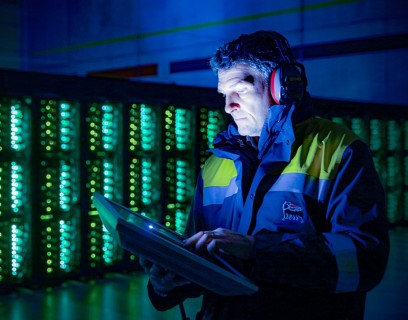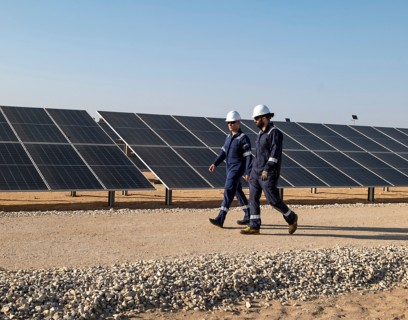I dati della pagina verranno aggiornati in seguito alla presentazione del Piano Strategico 2025-2028 di Eni.
Idrogeno, il potenziale di un vettore energetico
Il cammino verso la decarbonizzazione passa anche per l’H₂.

Il ruolo dell’idrogeno nel mix energetico
L’idrogeno potrebbe contribuire in modo significativo alla decarbonizzazione. Per esprimere tutte le potenzialità di questo prezioso vettore energetico applichiamo tecnologie produttive complementari e non concorrenti tra di loro, secondo il principio di neutralità tecnologica. Una efficace strategia deve riconoscere il contributo alla decarbonizzazione che possono dare tutte le forme di idrogeno low-carbon.
Cos’è l’idrogeno?
L’idrogeno è un vettore energetico che può immagazzinare e fornire grandi quantità di energia per unità di massa senza generare emissioni di CO₂ durante la combustione. È l’elemento più semplice e più abbondante del Pianeta e del Sistema Solare, ma è raramente disponibile allo stato libero e molecolare (H2), perché presente in combinazione con altri elementi chimici, per esempio acqua (H20) e idrocarburi (CH4). In ambito industriale si definisce idrogeno “grigio” quello ottenuto dal metano (la forma di produzione in assoluto più diffusa al mondo), idrogeno “blu” quello prodotto dal metano, ma con la cattura della CO2 emessa nel processo e idrogeno “verde” quello ottenuto dall’acqua tramite elettrolisi alimentata da fonti rinnovabili.
Ma l’idrogeno potrebbe essere considerato non solo un vettore energetico ma anche una fonte con grandi potenzialità secondo lo US geological Survey (https://www.usgs.gov/news/featured-story/potential-geologic-hydrogen-next-generation-energy) : le esplorazioni per la ricerca di idrocarburi hanno individuato in particolari contesti geologici, presenti ad esempio in Francia ed in Mali, giacimenti di idrogeno allo stato naturale non ossidato, quello che è stato definito Idrogeno Bianco.
Numeri in evidenza
Eni è il più grande produttore e consumatore di idrogeno in Italia, ma dobbiamo lavorare per riuscire a creare un sistema che permetta investimenti e sviluppo, che porti alla creazione di un vero e proprio mercato dell’idrogeno.
Claudio Descalzi
Amministratore Delegato di Eni

Le nostre attività nell’idrogeno
Siamo uno dei maggiori produttori e consumatori in Italia di idrogeno. A oggi, l’elemento è utilizzato principalmente come feedstock nei tradizionali processi di raffinazione oltre che nelle bioraffinerie a Venezia e Gela per la produzione di biocarburanti HVO, ovvero gli oli vegetali idrotrattati ideali per la mobilità sostenibile.
L’idrogeno in raffineria e bioraffineria viene utilizzato direttamente nei processi produttivi e prodotto principalmente attraverso una tecnologia a oggi consolidata nell’industria, che è lo Steam Methane Reforming (SMR). L’idrogeno low-carbon e cioè blu o verde, inoltre, rappresenta una soluzione alla decarbonizzazione di settori industriali altamente energivori e con emissioni di processo difficili da abbattere (i cosiddetti hard-to-abate), laddove l’elettrificazione non rappresenta un’opzione attualmente percorribile o risolutiva.
I nostri progetti sull’idrogeno
I processi e le tecnologie che stiamo sviluppando per produrre e utilizzare questo vettore energetico.
Centrali elettriche
Con Edison e Ansaldo Energia sperimentiamo la produzione di idrogeno da utilizzare in sostituzione al metano nella nuova centrale Edison di Marghera. L’idrogeno impiegato è sia “verde” che “blu”.
Sistemi di Cattura e Stoccaggio della CO₂
Stiamo lavorando per arrivare a produrre idrogeno blu e cioè attraverso impianti di Steam Reforming del gas naturale abbinati alla cattura della CO2 generata dal processo produttivo. In questo modo, vogliamo ridurre l’impatto carbonico dell’idrogeno utilizzato come feedstock dei nostri impianti, anche in un’ottica di progressiva decarbonizzazione dei nostri prodotti energetici. L’obiettivo della Cattura e Stoccaggio della CO2 (Carbon Capture and Storage – CCS) infatti è quello in primis di abbattere le emissioni di CO2 dell’industria pesante (raffinazione, siderurgia, vetro, chimica, cementifici, eccetera), favorendo al contempo anche lo sviluppo di una filiera dell’energia blu (idrogeno blu ed energia termoelettrica blu, prodotta da centrali a gas con cattura della CO2). In Italia esiste l’opportunità unica di produrre idrogeno blu nell’area di Ravenna, grazie alla realizzazione del progetto “Ravenna CCS” che, sfruttando la combinazione di giacimenti di gas offshore esauriti con infrastrutture ancora in funzione, fornirà un sito di stoccaggio sicuro della CO2 emessa dalle attività industriali dell’area, tra cui anche quelle per la produzione di idrogeno.
kGas
Stiamo sviluppando kGas, una tecnologia che serve a convertire il gas naturale in gas di sintesi, ovvero quella miscela di idrogeno e monossido di carbonio che costituisce una preziosa fonte di H₂ attraverso l’ossidazione parziale catalitica del gas naturale. Oltre a essere un sistema più efficiente sul fronte energetico rispetto a quelli disponibili in commercio, kGas è in grado di produrre gas di sintesi e idrogeno con una forte riduzione delle emissioni di CO₂ utilizzando eventualmente il biometano come materia prima. Questo processo potrebbe candidarsi a diventare la tecnologia di elezione per la produzione di idrogeno blu, poiché consente di effettuare la cattura di CO₂ con maggiore efficienza.
Elettrolisi dell’acqua
Stiamo sviluppando progetti di produzione di idrogeno a partire da fonti rinnovabili attraverso l’elettrolisi dell’acqua (il cosiddetto idrogeno verde). Una collaborazione in questo ambito è quella fra Eni ed Enel.
Due progetti sviluppati dalla Joint Venture South Italy Green Hydrogen, creata dalle due società, sono tra i beneficiari italiani di IPCEI Hy2Use, iniziativa di tredici Paesi della Commissione Europea che metterà a disposizione fino a 5,2 miliardi di euro per il settore dell'idrogeno. Sostenuti da IPCEI Hy2Use, i due impianti a idrogeno verde di South Italy Green Hydrogen saranno realizzati nella bioraffineria di Gela e nelle vicinanze della raffineria di Taranto, gli elettrolizzatori avranno capacità rispettivamente di 20 MW e 10 MW, entrambi con celle a membrana a scambio protonico (PEM - Proton Exchange Membrane). L’idrogeno che produrranno, ottenuto esclusivamente da fonti rinnovabili, contribuirà al processo di decarbonizzazione dei due stabilimenti.
L’idrogeno verde fa parte anche della collaborazione tra Cassa Depositi e Prestiti, Eni e Snam per la decarbonizzazione del sistema energetico. In dettaglio le tre società, nel rispetto della normativa applicabile (in primis della normativa in materia di unbundling), promuoveranno possibili iniziative congiunte, incluse partnership, finalizzate allo sviluppo della produzione, del trasporto e della commercializzazione dell’idrogeno verde. La cooperazione riguarderà anche la produzione e l’utilizzo di idrogeno nei trasporti ferroviari, facendo leva sulle competenze di Eni nella produzione elettrica e da energie rinnovabili e sulle competenze di Snam in ambito infrastrutture ed elettrolizzatori, nello stoccaggio e nelle soluzioni logistiche.
H2iseO
Abbiamo firmato una Lettera di Intenti con FNM SpA per avviare una collaborazione strategica sulla decarbonizzazione dei trasporti in Lombardia, in cui trova spazio anche l’idrogeno. La collaborazione, in particolare, si inserisce anche nel contesto del progetto H2iseO di FNM e Trenord (società partecipata da FNM), che punta a far diventare il Sebino e la Valcamonica la prima "Hydrogen Valley" italiana.
I nostri progetti sull’idrogeno
I processi e le tecnologie che stiamo sviluppando per produrre e utilizzare questo vettore energetico.
Centrali elettriche
Centrali elettriche
Con Edison e Ansaldo Energia sperimentiamo la produzione di idrogeno da utilizzare in sostituzione al metano nella nuova centrale Edison di Marghera. L’idrogeno impiegato è sia “verde” che “blu”.
Sistemi CCS
Sistemi di Cattura e Stoccaggio della CO₂
Stiamo lavorando per arrivare a produrre idrogeno blu e cioè attraverso impianti di Steam Reforming del gas naturale abbinati alla cattura della CO2 generata dal processo produttivo. In questo modo, vogliamo ridurre l’impatto carbonico dell’idrogeno utilizzato come feedstock dei nostri impianti, anche in un’ottica di progressiva decarbonizzazione dei nostri prodotti energetici. L’obiettivo della Cattura e Stoccaggio della CO2 (Carbon Capture and Storage – CCS) infatti è quello in primis di abbattere le emissioni di CO2 dell’industria pesante (raffinazione, siderurgia, vetro, chimica, cementifici, eccetera), favorendo al contempo anche lo sviluppo di una filiera dell’energia blu (idrogeno blu ed energia termoelettrica blu, prodotta da centrali a gas con cattura della CO2). In Italia esiste l’opportunità unica di produrre idrogeno blu nell’area di Ravenna, grazie alla realizzazione del progetto “Ravenna CCS” che, sfruttando la combinazione di giacimenti di gas offshore esauriti con infrastrutture ancora in funzione, fornirà un sito di stoccaggio sicuro della CO2 emessa dalle attività industriali dell’area, tra cui anche quelle per la produzione di idrogeno.
kGas
kGas
Stiamo sviluppando kGas, una tecnologia che serve a convertire il gas naturale in gas di sintesi, ovvero quella miscela di idrogeno e monossido di carbonio che costituisce una preziosa fonte di H₂ attraverso l’ossidazione parziale catalitica del gas naturale. Oltre a essere un sistema più efficiente sul fronte energetico rispetto a quelli disponibili in commercio, kGas è in grado di produrre gas di sintesi e idrogeno con una forte riduzione delle emissioni di CO₂ utilizzando eventualmente il biometano come materia prima. Questo processo potrebbe candidarsi a diventare la tecnologia di elezione per la produzione di idrogeno blu, poiché consente di effettuare la cattura di CO₂ con maggiore efficienza.
Elettrolisi dell’acqua
Elettrolisi dell’acqua
Stiamo sviluppando progetti di produzione di idrogeno a partire da fonti rinnovabili attraverso l’elettrolisi dell’acqua (il cosiddetto idrogeno verde). Una collaborazione in questo ambito è quella fra Eni ed Enel.
Due progetti sviluppati dalla Joint Venture South Italy Green Hydrogen, creata dalle due società, sono tra i beneficiari italiani di IPCEI Hy2Use, iniziativa di tredici Paesi della Commissione Europea che metterà a disposizione fino a 5,2 miliardi di euro per il settore dell'idrogeno. Sostenuti da IPCEI Hy2Use, i due impianti a idrogeno verde di South Italy Green Hydrogen saranno realizzati nella bioraffineria di Gela e nelle vicinanze della raffineria di Taranto, gli elettrolizzatori avranno capacità rispettivamente di 20 MW e 10 MW, entrambi con celle a membrana a scambio protonico (PEM - Proton Exchange Membrane). L’idrogeno che produrranno, ottenuto esclusivamente da fonti rinnovabili, contribuirà al processo di decarbonizzazione dei due stabilimenti.
L’idrogeno verde fa parte anche della collaborazione tra Cassa Depositi e Prestiti, Eni e Snam per la decarbonizzazione del sistema energetico. In dettaglio le tre società, nel rispetto della normativa applicabile (in primis della normativa in materia di unbundling), promuoveranno possibili iniziative congiunte, incluse partnership, finalizzate allo sviluppo della produzione, del trasporto e della commercializzazione dell’idrogeno verde. La cooperazione riguarderà anche la produzione e l’utilizzo di idrogeno nei trasporti ferroviari, facendo leva sulle competenze di Eni nella produzione elettrica e da energie rinnovabili e sulle competenze di Snam in ambito infrastrutture ed elettrolizzatori, nello stoccaggio e nelle soluzioni logistiche.
H2iseO
H2iseO
Abbiamo firmato una Lettera di Intenti con FNM SpA per avviare una collaborazione strategica sulla decarbonizzazione dei trasporti in Lombardia, in cui trova spazio anche l’idrogeno. La collaborazione, in particolare, si inserisce anche nel contesto del progetto H2iseO di FNM e Trenord (società partecipata da FNM), che punta a far diventare il Sebino e la Valcamonica la prima "Hydrogen Valley" italiana.
Hydrogen JRP: una piattaforma per lo sviluppo delle tecnologie legate all’idrogeno
Per dare impulso alla creazione di una filiera idrogeno in Italia, abbiamo creato insieme alla Fondazione Politecnico di Milano e il Politecnico di Milano, Edison e Snam la piattaforma di ricerca congiunta Hydrogen Joint Research Platform (Hydrogen JRP), dedicata allo sviluppo delle tecnologie legate all’idrogeno. I principali ambiti identificati sono:
● produzione dell’idrogeno pulito (verde e “low carbon”)
● soluzioni per il suo trasporto e relativi sistemi di accumulo avanzati
● impieghi innovativi di tipo elettrochimico e termico in applicazioni residenziali, industriali e di trasporto
● sviluppo di best practice per la progettazione e realizzazione delle infrastrutture per il trasporto e lo stoccaggio dell’idrogeno.
Un valore per mobilità ed elettricità
L'idrogeno è una promettente opzione per la mobilità sostenibile a medio termine, in particolare per i settori dei trasporti difficili da decarbonizzare, come il trasporto stradale pesante e a lungo raggio. Nel lungo termine, potrebbe anche trovare impiego nel settore della mobilità marittima. Tuttavia, lo sviluppo dei trasporti basato sull'idrogeno in Europa è limitato dagli elevati costi di produzione e distribuzione, oltre alla mancanza di infrastrutture adeguate. Con Enilive a giugno 2022 abbiamo inaugurato a Venezia Mestre la nostra prima stazione di servizio per il rifornimento di idrogeno per la mobilità, in ambito urbano e aperta al pubblico. Inoltre, abbiamo partecipato con successo a tre bandi PNRR per realizzare stazioni a idrogeno in tre città:
- nella terraferma di Venezia nell’ambito del trasporto pubblico e del rifornimento privato
- a San Donato Milanese per il trasporto privato, pesante e leggero
- a Taranto, per il trasporto pesante e leggero legato al porto e all’area industriale.
Inoltre, Eni sta sviluppando competenze nel campo della combustione di miscele di idrogeno e gas naturale nelle turbine a gas esistenti. Questa tecnologia mira ad aumentare la percentuale di idrogeno utilizzata per alimentare le turbine a gas Enipower, consentendo così la generazione di elettricità a basso contenuto di carbonio.




















